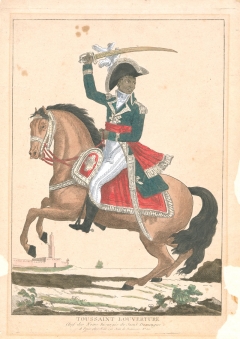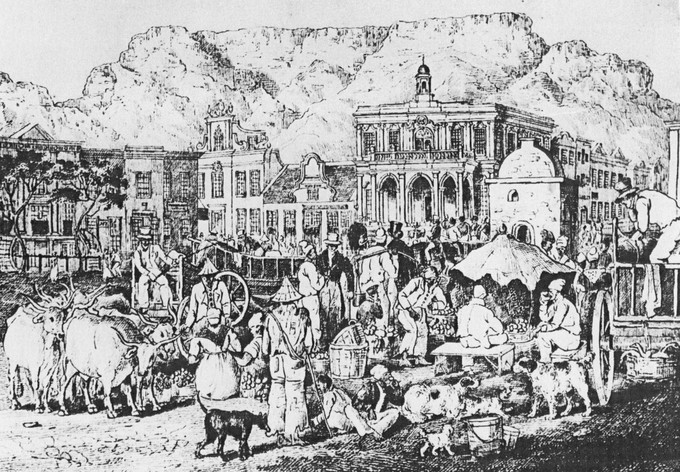The unique nature of slavery in the Cape Colony hindered many attempts at wide-scale resistance on the part of Cape slaves. Instead many slaves’ attempts at resisting and deposing their enslavement was on an individual level, most often through overt attacks on property and individuals, and less often through more passive means such as working slowly, poisoning food or drink and breaking equipment. More often than not however slaves opted for desertion, escaping the boundaries of the colony into the interior.
When slaves did however attempt to organise and execute resistance on a group level, it was on many occasions short-lived and quickly quashed by colonial authorities who were more often than not greater in number and equipped with stronger artillery. This was the case with the slave uprising of 27 October 1808, led by a Mauritian slave tailor who went by the name of Louis. Louis had arrived at the Cape from Mauritius at a very young age and by 1808 was in his early twenties. His slave-owner was the proprietor of a wine store in Cape Town which exposed Louis, and many other Cape slaves alike, to the ideas and news which accompanied the many sailors and soldiers passing through the Cape. Most notably, these transients brought news of revolution and war taking place in other slaveholding societies such as the Americas and the Caribbean. News surrounding the abolition of the slave trade had also crossed the oceans of the colonial world and had surely planted seeds of hope to the enslaved. It was however the slave uprisings taking place in Haiti (1791-1804), during what has since been termed the ‘Haitian Revolution’, which began to stir up ideas of revolt amongst Louis and his comrades.
Events began when Louis met two Irishmen, James Hooper and Michael Kelly, who Louis later claimed had informed him that slavery had ended in both Europe and the Americas. Louis stated that he had heard, ‘that in other countries all persons were free, and there were so many Black people here who could also be free, and that we ought to fight for our freedom.’ [i] Louis and the Irishmen were also joined by another six conspirators – a slave called Jeptha of Batavia, two other slaves Abraham and Adonis, another Indian slave who has remained unnamed and two Khoikhoi men. The group planned to march from the rural districts and gather as many slaves and farm labourers as possible on their way into Cape Town before seizing the Amsterdam Battery. After that, they planned to turn their weapons on the Castle and attempt a peaceful negotiation to establish freedom for all slaves.
 An image of Toussaint l’Ouverture, leader of the Haitian slave revolt and inspiration to Louis van Mauritius. Image source
An image of Toussaint l’Ouverture, leader of the Haitian slave revolt and inspiration to Louis van Mauritius. Image source
On the evening of 27 October 1808, the conspirators assembled on the farm of a Gerhardus Louw, just north of present day Malmesbury. With the Irishmen disguised as British officers, the group managed to convince the absent farmer’s wife to hand over all their slaves into the hands of the ‘military’ party. They even managed to convince the farmer’s wife to supply them with an evening meal and a place to rest for the night. When morning came, the group proceeded from farm to farm in the Swartland and Koeberg hinterland of the Cape and managed to successfully persuade slaves and Khoikhoi farm labourers to join in the uprising. They initially faced very little resistance and managed to gather a group of over 300 mutinous slaves and servants. Why the farmers didn’t do more to resist and defend their property and families can most likely be explained by three simple factors. The sheer sight of such a massive and organised crowd would have confirmed the very worst nightmares of many European farmers in the Colony at the time. The group were also well-armed and would have easily overpowered any farmer making resistance almost impossible. Furthermore, the group were reported to have moved quickly from farm to farm, allowing them to catch each farmer by surprise. Only one farmer is reported to have fought back, a certain Hendrik Prehn. Even then however, it was only after he had been bound by the resistors that he was able to break loose and fire a gun at them.
The resisters themselves were not on the whole physically violent but instead acted with considerable moderation - in comparison to similar revolts elsewhere in the world. The farmers who they had encountered on the farms were mishandled and often tied up but no lives were lost. There is however an account of the severe manhandling of a farmer by the name of Adriaan Louw who was reportedly grabbed by his hair, hit over the head and on his back with the butt of a musket and pulled along the floor to the wagons. Property of the farmers however, suffered most. In most cases the farms were completely looted of all horses, arms and ammunition. Seven farms are recorded to have had their windows completely smashed and doors ripped off with the contents of their homes and chests looted. In some cases the cellars of the farms were even opened and wine distributed among the resisting slaves.
The 340 attacked over thirty prosperous grain farms in the region and went as far as to take many farmers captive in the process. From there the group marched into Cape Town where they had planned to ‘hoist the bloody flag and fight themselves free.’ [ii] A mere 36 hours after the insurrection had begun, it was quelled, as the group were met by both the Infantry and the Cavalry at Salt River. While many scattered, the troops managed to capture 326 of the marchers. Of the 326, 47 were put on trial. Louis himself, and one of the Irishmen James Hooper were found guilty of treason and sentenced to be hanged. A further 11 were sentenced to death for ‘active participation’ while others were given lesser sentences including imprisonment on Robben Island. [iii]
 Greenmarket square in the 1830s Image source
Greenmarket square in the 1830s Image source
While on paper it may seem that the uprising of 1808 was relatively unsuccessful in reality it was an extremely significant event. It represented the new sense of resentment felt amongst the slaves in the Cape Colony toward the end of the eighteenth century. What also added to the distinctive nature of the 1808 revolt was the intriguing ways in which the rebels behaved. Instead of asserting purely physical violence and intimidation, the revolting slaves asserted themselves symbolically too. It is recorded that the slaves deliberately reversed the slave-master relationship. On horseback, the revolting slaves gave orders to male farmers while holding sjamboks which had become the symbol of slave ownership and dominance at the time. Furthermore, they deliberately addressed the captive farmers using the word ‘jij’ rather than the usual ‘u’ which was respectful and the expected way for a slave to address their master. The criminal sentence later explained the use of ‘jij’ as ‘a disrespectful expression in the Dutch language’. [iv] Louis went one step further, obtaining very specific clothes to wear. He wore, ‘a blue jacket turned up with red, white Chinese linen trousers … two golden and two silver epaulets besides some feathers for his hat.’ [v] This uniform was similar to the one worn by Toussaint l’Ouverture, slave leader of the Haitian Revolution, and clearly signifies the influence that slave resistance movements elsewhere in the world had on the resisting slaves of the Cape in 1808.
For 36 hours the roles of master and slave were reversed and the hierarchy of the Cape turned on its head. Abraham, one of the original conspirators of the insurrection, aptly explained to a slave women weeping for her master: ‘Tomorrow the troupe will hoist a red flag and fight itself free, and then the slave women will all be able to say Jij to their mistresses.’ [vi] While the rebellion was short-lived, its effects were most certainly felt. In the years to follow, more slaves at the Cape stood their ground and rather than deserting as they had in the past, began to demand rights within the colony. This, paired with the actions of abolitionists both far and near, eventually led to the collapse of the institution of slavery in the 1830s.
Endnotes
[i] Worden, Nigel. ‘How a slave from Mauritius led a rebellion in Cape Town.’ 30 March 2016. Available at : https://www.groundup.org.za/article/how-slave-mauritius-led-rebellion-cape-town/. ↵
[ii] Ibid. ↵
[iii] Ross, Robert. Cape of Torments. (London: Routledge, 1993). ↵
[iv] Ibid, pg. 103. ↵
[v] Worden, Nigel. ‘How a slave from Mauritius led a rebellion in Cape Town.’ ↵
[vi] Ross, Robert. Cape of Torments, pg. 103. ↵